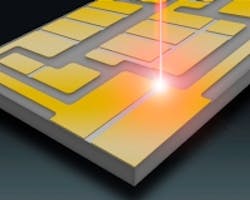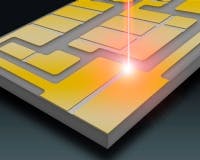Laser welding in the right light
Aachen, Germany – Laser welding is on the advance, but it also has its limits. For example, it had been impossible to fuse two transparent plastic components together – up until now. Researchers have now succeeded in circumventing this hurdle – by choosing the right wavelength. The new welding process is revolutionizing bioanalytics.
It’s a quick process, generates almost no waste, and is extremely precise. Within a few seconds, a laser beam has welded a casing and speedometer cover together – without any screws, clamps or glues whatsoever. The result is a perfect weld seam scarcely visible to the naked eye. There are no sparks or particles flying through the air during welding. What’s more: the resulting heat is confined to a minimal area. This protects the material. Many industries have now turned to welding plastics with a laser.
Still, the technology has its limits; when it comes to fusing two plastic components together, for instance, there was little freedom of choice. Up until now, the upper joining part had to be transparent to permit the laser to shine through unimpeded while the lower joining part absorbed the radiation. This usually meant soot particles had to be blended into the plastic. These particles absorb the energy of the laser beam and transmit the fusion heat generated to the upper joining part.
"Up until now, you usually had to choose a single plastic combination: transparent and black. There are lots of applications – in medical technology, for instance – where what’s needed is a combination of two transparent plastics," explains Dr.-Ing. Alexander Olowinsky, project manager at the Fraunhofer Institute for Laser Technology ILT in Aachen. The researcher and his team have now managed to erase the previous boundaries of laser welding.
"The industry now also makes infrared absorbers that are nearly transparent, but these are very expensive and also have a green, yellowish tint to them," Olowinsky elaborates. "So our goal was to find a way to get the job done completely free of absorber materials."
To accomplish this, researchers studied the absorption spectra of a range of transparent polymers in search of wavelength ranges within which plastic absorbs laser radiation. Then the scientists tested and perfected the laser systems to match: systems that emit light of the right wavelengths.
"Before, you didn’t have the right light source," Olowinsky adds. "It was only during the past few years that laser sources have been developed that emit light in these wavelength ranges." To deliver the light energy to the joining level – to the seam along the border between the two transparent plastics – the experts at ILT came up with special lens systems. These systems focus the beam so that the highest energy density occurs at the beam waist – where the beam diameter is the smallest – so that the highest temperature is delivered precisely to the joining level.
The researchers’ most promising results were achieved at a wavelength of around 1700 nm. "This is the peak welding-efficiency range," Olowinsky summarizes. Nevertheless, the researchers are also continuing work on the EU Commission-sponsored "PolyBright" project () in search of the combination of the right absorption bands with the matching light sources. "The result has to be the most cost-effective laser system possible that can execute high-precision welding tasks at the highest possible speed."
This laser welding development is just one of many process developments that will be discussed at the Laser World of Photonics Trade Fair and Congress to be held in Munich from May 23 to 26, 2011.

